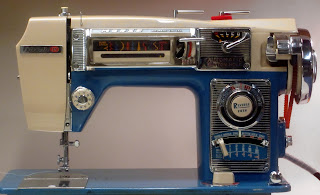It's so crazy looking but is a real testament to the engineering talent / eccentricity at White. It reminds me of those Pachinko machines we heard about.
By the late 60's car styling had become very hard edged and still quite creative inside and out. Fed Reg's had not yet started to homogenize design so things like the 1966 Thunderbird were aggressive and flamboyant.
For some reason I really like the "tail fin" speed form leading up to the hand wheel.
11.14.11
A little update on sewing with the Fotomatic; it is very sure footed, it starts thru most anything without help. I have no idea why this particular machine is different than the others because let's face it... it is another Japanese machine from the 60's. Regardless it just goes thru my light weight leather without a fault. A strange thing does occur occasionally, the bobbin thread jumps out of the diagonal slot , when this happens the everything goes out of whack but from the top things look OK so you need to catch this early. This may not be a 4400 problem, just a bobbin case problem?
50













































